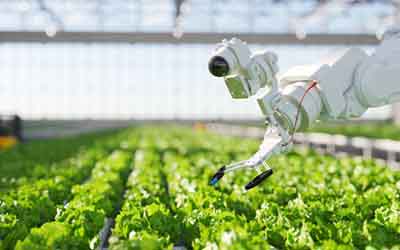The Green Revolution refers to a series of research, development, and technology transfer initiatives that occurred between the 1940s and 1960s.
Its primary objective was to significantly increase agricultural production around the world by introducing high-yielding varieties of crops, paired with modern farming techniques.
Historically, the world faced a daunting challenge in the mid-20th century. The global population was surging, and many countries, especially in Asia and Latin America, were grappling with the specter of famine and widespread hunger.
The traditional methods of farming, reliant on age-old practices and native crop varieties, were insufficient to meet the burgeoning food demand.
The significance of the Green Revolution cannot be overstated. It fundamentally changed the way the world farmed and consumed food. Fields that once produced meager yields began to burgeon with grains, feeding millions and turning food-deficit countries into food-surplus regions.
What is the green revolution in agriculture? Historic view
The story of the Green Revolution is intrinsically linked with the narrative of a single individual whose efforts and determination brought about monumental change in the world of agriculture: Dr. Norman Borlaug.
Often referred to as the “father of the Green Revolution,” Borlaug’s work set the stage for one of the most transformative periods in global agricultural history.
Norman Borlaug and His Pioneering Efforts
Born in 1914 on a small farm in Iowa, Norman Borlaug’s journey in agriculture began early. His passion for plants, paired with a profound sense of responsibility to address global hunger, led him to Mexico in the 1940s. It was here that he undertook the monumental task of developing disease-resistant, high-yielding varieties of wheat.
Through rigorous cross-breeding and innovative techniques, Borlaug and his team succeeded in creating strains of wheat that not only resisted the deadly stem rust fungus but also yielded far more grain than traditional varieties.
This breakthrough was not just a scientific achievement; it marked the beginning of a new era in agriculture. Borlaug’s wheat varieties were introduced to countries around the world, most notably India and Pakistan, where they sparked a dramatic surge in wheat production.
Addressing Famine and Food Scarcity
The backdrop against which the Green Revolution emerged was grim. The mid-20th century witnessed an unprecedented rise in global population. Countries, especially in Asia and Latin America, stared down the barrel of severe food shortages.
Traditional farming practices, while culturally significant and sustainable in many respects, were not producing enough to feed the swelling masses. The threat of famine loomed large, and food scarcity became a dire concern, leading to political, social, and economic instability in many regions.
The situation was especially critical in countries like India, where consecutive years of drought exacerbated food shortages. Importing grains became a necessity, but it was a stop-gap solution at best.
Key Components of the Green Revolution
The Green Revolution wasn’t just about introducing a few new types of crops; it was a multifaceted movement that integrated various agricultural innovations to achieve the goal of boosting food production.
These innovations became the key pillars that supported the sweeping changes witnessed in global agriculture during this period.
High-yielding varieties (HYVs) of crops
At the heart of the Green Revolution were the High-Yielding Varieties (HYVs) of crops. These were specially bred strains designed to produce more grain per unit of land than traditional varieties.
While Norman Borlaug’s wheat was among the first, soon there were HYVs for rice, maize, and other staple crops.
These HYVs had a few common characteristics:
- Shorter growing periods, which allowed farmers to cultivate more than one crop per year.
- Dwarfing genes, resulting in shorter, sturdier plants less prone to lodging (falling over), which was especially important given the heavier grain loads they carried.
- Enhanced responsiveness to fertilizers, ensuring that when provided with adequate nutrients, their yield potentials were maximized.
The role of chemical fertilizers and pesticides
HYVs, while potent, demanded more from the soil in terms of nutrients. To meet these needs, there was a substantial increase in the use of chemical fertilizers. Nitrogen, phosphorus, and potassium-based fertilizers became commonplace, providing crops with essential nutrients and significantly boosting yields.
With the increased monoculture of HYVs, pests and diseases that could exploit these uniform crops became a concern. This led to the widespread use of chemical pesticides and insecticides to protect crops and ensure high yields.
Improved irrigation techniques
Relying on seasonal rains was not an option for ensuring the consistent growth of HYVs. As a result, there was a push towards developing improved irrigation techniques and infrastructure. Canals, tubewells, and pumps became more widespread.
Techniques like drip irrigation and sprinkler systems, which deliver water directly to the plant roots or above the plants, were introduced in areas where water was scarce, ensuring efficient water use.

Mechanization of farming processes
The Green Revolution also heralded a shift from manual labor to mechanized farming. Tractors replaced bullocks for plowing fields, increasing the speed and efficiency of preparing land.
Combine harvesters, which can reap, thresh, and winnow crops in one go, were introduced, significantly reducing the time and labor needed for harvesting.
Other machinery, like seed drills and automated planters, made sowing more efficient. This mechanization not only reduced the dependency on manual labor but also allowed farmers to manage larger plots of land, leading to economies of scale and higher overall production.
Achievements of the Green Revolution
The Green Revolution stands as a pivotal chapter in the annals of agricultural history.
It fundamentally altered farming paradigms and had lasting impacts on food production and global food politics. Here, we’ll delve into the key achievements of this transformative movement.
Dramatic increase in global food production
Perhaps the most celebrated achievement of the Green Revolution was the sheer magnitude by which it increased food production.
Before its onset, many regions faced the daunting possibility of famine and hunger due to rapidly rising populations and stagnant agricultural yields.
For perspective:
- Wheat yields in developing countries doubled between 1965 and 1985.
- Rice yields in Asia experienced a similar surge, with countries like India and the Philippines seeing yield increases of up to 2-3 times.
Countries that benefited most from Green Revolution
Several countries were front-runners in adopting the Green Revolution’s practices and, in turn, reaped its benefits most significantly.
- India
From being a country that relied heavily on food imports to address its shortages, India transformed into a self-sufficient nation in terms of staple grains by the 1970s.
The state of Punjab led this change, earning the moniker “Granary of India.” The introduction of HYV wheat and rice changed the agricultural landscape of the nation.
- Pakistan
Similar to its neighbor, India, Pakistan also faced food deficits in the 1960s. The introduction of Green Revolution technologies, especially HYV wheat, led to a significant increase in food grain production, making the country self-reliant.
- Mexico
As the birthplace of the Green Revolution, Mexico showcased the potential of HYVs early on.
The country not only became self-sufficient in wheat production but also turned into an exporter by the early 1960s.
Reduction in food prices and improved food security
With the surge in food production, the laws of supply and demand naturally led to a decrease in the prices of staple grains. More affordable food meant better access for a larger segment of the population, leading to improved food security.
- Families that previously struggled to afford staples found them more within reach.
- Nations that once drained significant portions of their foreign reserves to import grains were now saving or reallocating those funds for other developmental projects.
Criticisms and Concerns of the Green Revolution
While the Green Revolution made remarkable strides in food production and brought security to billions, it wasn’t without its detractors.
Over the years, various criticisms have been raised against its practices and impacts, some of which continue to shape contemporary agricultural discourse.
- Soil Degradation: The intensive use of chemical fertilizers, particularly in regions where they were applied without proper understanding or in excessive amounts, resulted in the deterioration of soil health. Over time, soils lost their natural fertility and became reliant on synthetic inputs.
- Water Depletion: The high-yielding varieties developed during the Green Revolution often required more water than traditional crops. Coupled with the spread of irrigation, this led to the over-extraction of groundwater in many areas.
- Loss of Biodiversity: The focus on a few high-yielding varieties meant that many traditional and indigenous crop varieties were neglected and, in some cases, disappeared altogether.
- Small Farmer Displacement: The mechanization and commercialization of agriculture favored larger farms and those who could afford the necessary inputs and technology.
- Increased Debt: With the need for new seeds, fertilizers, pesticides, and machinery, many farmers took on debt.
- Dependence on Agribusiness: The shift towards commercialized farming increased farmers’ reliance on a few major agribusiness corporations for seeds, chemicals, and other inputs.
Health Concerns Related to the Use of Chemicals
The widespread use of chemical pesticides and fertilizers introduced new health concerns. Pesticide residues on food and in water sources, as well as long-term exposure for agricultural workers, became significant issues.
Regions with intense chemical use reported higher incidences of health problems, including cancers, respiratory issues, and other ailments.
Loss of Traditional Farming Practices and Native Crop Varieties
With the shift to modern agricultural practices, centuries-old farming techniques often tailored to local ecosystems and sustainable in nature were sidelined.
These traditional practices, passed down generations, were lost in many communities.
Alongside, the diversity of native crop varieties, each with its unique flavor, resilience, and nutritional profile, dwindled as the focus narrowed to a few high-yielding strains.
Climate Change and its Challenges
The world today faces an adversary that threatens every aspect of human life: climate change. Rising temperatures, erratic rainfall patterns, prolonged droughts, and frequent extreme weather events pose significant challenges to agriculture.
Farms are expected to produce more to feed a growing population but with fewer resources and under increasingly unpredictable conditions.
- Sea-level rise threatens fertile deltas and coastal regions, which are major food-producing areas.
- Warmer temperatures can reduce yields of staple crops and can also enhance the spread of pests and diseases.
- Water scarcity, intensified by changing rain patterns and melting glaciers, poses a challenge to irrigation-dependent agriculture.
Emphasis on Sustainable Practices
- Conservation Agriculture:
This involves practices that conserve soil and water, such as no-till farming, crop rotation, and the use of cover crops. Such methods improve soil health, increase water retention, and can even enhance carbon sequestration in the soil.
- Organic Farming
A move away from synthetic chemical inputs, organic farming relies on natural processes and inputs for pest control, soil fertility, and disease management. This approach not only reduces the environmental impact but also caters to a growing market of consumers seeking organic produce.
- Agroforestry
Integrating trees with crops and livestock systems, agroforestry brings multiple benefits. Trees can act as windbreaks, improve soil quality, provide additional income sources, and enhance biodiversity.
Technological Innovations Supporting Sustainability
- Precision Agriculture
Leveraging technology, such as drones, sensors, and data analytics, precision agriculture ensures that crops get the exact amount of water, nutrients, and pesticides they need. This optimization reduces wastage and environmental impact.
- Genetically Modified Organisms (GMOs) with a focus on Drought Resistance
While GMOs are a topic of debate, there’s no denying their potential in addressing climate challenges. Scientists are developing crop varieties that are drought-resistant, salinity-tolerant, and can thrive in sub-optimal conditions, ensuring food security in a changing climate.
- Mobile and Digital Technology
From apps that provide real-time weather forecasts to platforms connecting farmers to markets, technology is playing a pivotal role in making agriculture more sustainable and efficient.
The Future of Agriculture Beyond the Green Revolution
While the Green Revolution marked a significant turning point in the history of global agriculture, the challenges of the 21st century call for a broader vision.
The future of agriculture demands a synthesis of lessons from the past with the innovations of the present, ensuring food security while respecting ecological boundaries and cultural contexts.
- Value of Indigenous Practices
Indigenous and local farming communities around the world have cultivated a wealth of knowledge through centuries of interaction with their environment.
Techniques like crop rotation, intercropping, and natural pest control have been practiced for generations and can offer sustainable solutions to contemporary challenges.
- Bridging the Gap with Technology
Modern technology can help amplify the benefits of traditional practices. For example, using data analytics to optimize crop rotation schedules or employing drones to monitor intercropped fields can enhance yield while ensuring sustainability.
- Bioinformatics and Ethnobotany
Combining traditional knowledge about plants with modern tools of genetics can lead to the discovery of new crop varieties or the development of sustainable agricultural products.
- Small Farms, Big Potential
While large-scale farms have their place, small-scale farmers manage over 80% of the world’s farmland. Ensuring they have access to resources, training, and markets is crucial for global food security.
- Local Knowledge as an Asset
Local farmers possess an intimate understanding of their ecosystems. Their experiential knowledge about soil health, local pests, and microclimates can inform and enhance modern agricultural practices.
- Collaborative Research
Instead of a top-down approach where experts dictate practices, the future lies in collaborative research, where farmers and scientists work hand-in-hand to co-create solutions tailored to local contexts.
Concluding remark on What is the green revolution in agriculture
The Green Revolution, a monumental shift in agricultural practices during the mid-20th century, stands as a testament to human ingenuity and determination.
Born out of an urgent need to combat impending famines and food shortages in a rapidly growing world, it revolutionized farming through the introduction of high-yielding crop varieties, the extensive use of chemical fertilizers and pesticides, mechanization, and improved irrigation. The results were staggering; nations that were on the brink of severe food crises transformed into self-sufficient entities, with some even becoming net exporters of food grains.
This incredible feat of significantly raising global food production cannot be understated. It not only averted large-scale famines but also improved the livelihoods of millions of farmers, stabilized economies, and played a pivotal role in supporting global population growth during the latter half of the 20th century.
Socio-economic challenges, including the marginalization of small-scale farmers and the loss of traditional agricultural knowledge, emerged as significant concerns.
This brings us to the present juncture. With the world facing a new set of challenges, including the alarming threats posed by climate change, it’s evident that the agricultural strategies of the past, no matter how revolutionary, cannot be the sole solutions for the future.
The need of the hour is to integrate the lessons from the Green Revolution with contemporary knowledge and technology. Sustainability, inclusivity, and adaptability must be the guiding principles as we chart the path forward.
The journey of understanding the Green Revolution and the imperative shift towards sustainable agriculture is not just a passive learning endeavor. It’s a call for each one of us to play our part in shaping a future where food is plentiful, and the Earth is cared for. Here’s how you, dear reader, can actively participate and be a beacon of change:
Recommendations
Best precision agriculture technologies
How To Become An Agriculturist
Artificial intelligence in agriculture projects (You don’t want to miss reading about this one)



